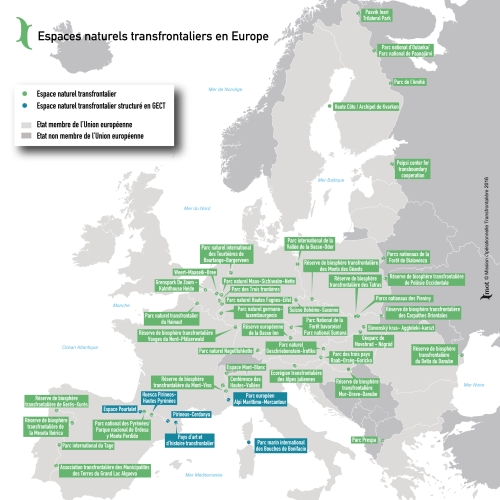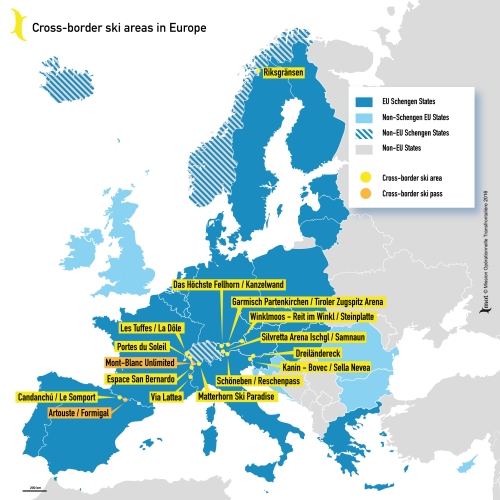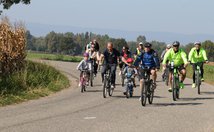Tourism
Overview
Typology and examples of project
Cross-border tourism projects can be sorted into two categories: some transpose to a cross-border level pre-existing tourism offerings (homogenisation of offerings, joint marketing and promotion, networking…) while others are conceived from the outset in a cross-border dimension.
- JOINT MANAGEMENT, PROMOTION AND NETWORKING OF CULTURAL AND TOURIST SITES IN BORDER AREAS
Joint entry ticket systems for tourist sites
Border territories seek to facilitate entry to tourism sites through the creation of “museum passes”, like the Museums-PASS-Musées allowing entry to 320 museums, castles and gardens in France, Switzerland and Germany; or the “Pass découverte” in the Strasbourg-Ortenau Eurodistrict.
Development of cross-border guides and maps
Guides and maps allow tourists to better navigate cross-border areas and to understand the neighbouring culture. Examples include the guide and map of the Lille-Kortrijk-Tournai Eurometropolis and the Greater Region’s tourism brochure “Bienvenue dans la Grande Région”.
Creating and promoting a cross-border tourism offering
In the digital era, numerous territories are developing joint internet portals (“Léman sans frontière” for the Greater Geneva area) or smartphone applications (“Traverse” at the French-Swiss border, or “Smart Destination” at the French-Italian border) in order to promote tourist destinations to a broad target audience.
Networking of existing tourist attractions
Some cross-border projects bring together tourist attractions from either side of the border in order to promote them at a cross-border level. For example, the “Jardinalp” project brings together 8 French and Italian alpine gardens, the “Singular Roads” project covers 6 small and medium-size towns at the French-Spanish border, and the “Terra Salina” project brings together 4 historic salt production sites in France and Switzerland.
Promotion of sustainable tourism, development of eco-tourism
The major challenge for the sector is to ensure the sustainable development of tourist destinations. The “Green Pyrenees Slow Tourism” project promotes the revitalisation of the Pyrenees by encouraging “slow mobility” modes of travelling. The Lille-Kortrijk-Tournai Eurometropolis project “Espace bleu” aims to develop sustainable tourism by redeveloping spaces around watercourses.
Supporting tourism stakeholders
As well as targeting tourists themselves, some cross-border tourism projects are also aimed at professionals in the sector. The projects “Transfrontour” and “Ardenne Ecotourism” support professionals (including accommodation providers and site managers) in their development of a tourism offering adapted to the cross-border context. The goal is to facilitate a networking of players, to ensure the exchange of good practice and to promote responsible management of tourism activities.
- CREATION OF CROSS-BORDER TOURISM FACILITIES
Creation of cross-border sightseeing itineraries and tours
In the creation of new sightseeing tours, cross-border territories aim to showcase natural areas that are crossed by the border. In the spirit of green tourism, these tours are conceived for “soft mobility” – cyclists and walkers. The projects “Ardenne cyclo” (France-Belgium), “TransGarona” (France-Spain), and “VéloViso” (France-Italy) are working on the creation and linking up of tourist cycling routes in a cross-border dimension. The project "Greenlinks" seeks to develop greenways between the three constituents of the Lille-Kortrijk-Tournai Eurometropolis in order to enable walkers to discover the territory in a seamless manner. The historic “Alta Via del Sale” or High Salt Road at the French-Italian border creates a cross-border liaison for motorcycling and off-road vehicle enthusiasts.
The Strasbourg-Ortenau Eurodistrict, through its “Vélo Gourmand” project, aims to promote a Franco-German cycling route by enriching it with a food and drink aspect – tasting sessions of local products are organised along the whole route.
Construction of new cross-border infrastructure
A lack of accessibility to tourist sites on either side of the border can become a significant obstacle: hence the necessity for creating new infrastructure to boost tourism. The Salève cable car at the French-Swiss border enables visitors to reach a unique panoramic viewpoint over Geneva, and to go paragliding, climbing, hiking, and skiing. The Pyrenean “Géotrain” facilitates access to geotourism, with the railway in the Pyrenees territory.
Development and promotion of protected natural areas
Natural areas close to borders can be better promoted with the creation of cross-border nature parks, or enhanced cooperation between parks situated on either side of the border. For example, four parks straddling the borders between Spain, France and Andorra have come together to form the Three Nations Park; the Scarpe-Escaut Regional Nature Park in France, and the Plaines de l'Escaut Nature Park in Belgium cooperate within the framework of the Hainaut Cross-border Nature Park. Another example: two national parks at the French-Spanish border, the Pyrenees National Park and the Ordesa y Monte Perdido National Park cooperate within the “Pyrénées – Mont Perdu” cross-border site, a UNESCO world heritage site since 1997, with three axes of cooperation: “Improving knowledge of the world heritage site”, “Developing a cross-border tourism offering”, and “Awareness-raising, transmission, sharing” (defined in the framework of the POCTEFA programme).
At the Franco-German border, the PAMINA Rhine Park aims to create a “museum region” at the heart of the cross-border territory – a network of “discovery and interpretation trails” enabling hikers to discover landscapes on both sides of the Rhine.
Promotion of border mountain ranges
Tourism is a significant concern for border mountain ranges, where it is an important vector for activity and attractiveness. Tourism contributes to the economic vitality of mountainous regions and job creation. The Alps are the mountain range that is most subjected to tourism pressure, notably around Mont Blanc. The Espace Mont-Blanc initiative aims to better reconcile the heavy tourism presence with the need to protect the exceptional natural and environmental heritage; it has dedicated itself to the project “Autour du Mont-Blanc” (Around Mont Blanc), proposing thematic tours for walkers. At the French-Italian border, the ambitious “Terres Monviso” project around Monte Viso brings together French and Italian partners within the framework of an “Integrated Territorial Plan” (PITER), proposed by the 2014-2020 ALCOTRA programme. The goal is to implement a common strategy for the development of the cross-border territory and of “tourism without borders”. The EU subsidies will be distributed along four axes: the green economy, mobilities and risk management, international tourism, and “ageing well”.
In the territories of cross-border mountain ranges, European Groupings of Territorial Cooperation (EGTCs) have been established more extensive cooperation: Pirineos-Pyrénées EGTC, Pirineus-Cerdanya EGTC and Cross-border Country of Art and History EGTC on the French-Spanish border; and the Alpi Marittime-Mercantour European Park EGTC on the French-Italian border. All of these EGTCs include a focus on cross-border cooperation in the field of tourism.
Cross-border promotion of winter sports
Concerning winter tourism, there exist several cross-border ski resorts – the Portes du Soleil EIG (France-Switzerland), Espace San Bernardo (France-Italy), Via Lattea (France-Italy) – and a cross-border ski pass: Mont-Blanc Unlimited. Certain resorts close to borders have chosen to link their infrastructure (ski lifts, cable cars), while others have chosen to link their ski slopes (see map).
Photo : Vélo Gourmand de l'Eurodistrict Strasbourg Ortenau.
Copyright : Isabelle Hipp

- Cross-border tourism initiatives for winter sports: winter sports contribute to the development of mountainous regions. Certain European ski resorts are located close to national borders. Several of them have chosen to link their infrastructure (chairlifts [the Portes du Soleil EEIG for example], cable cars) or their ski slopes.



